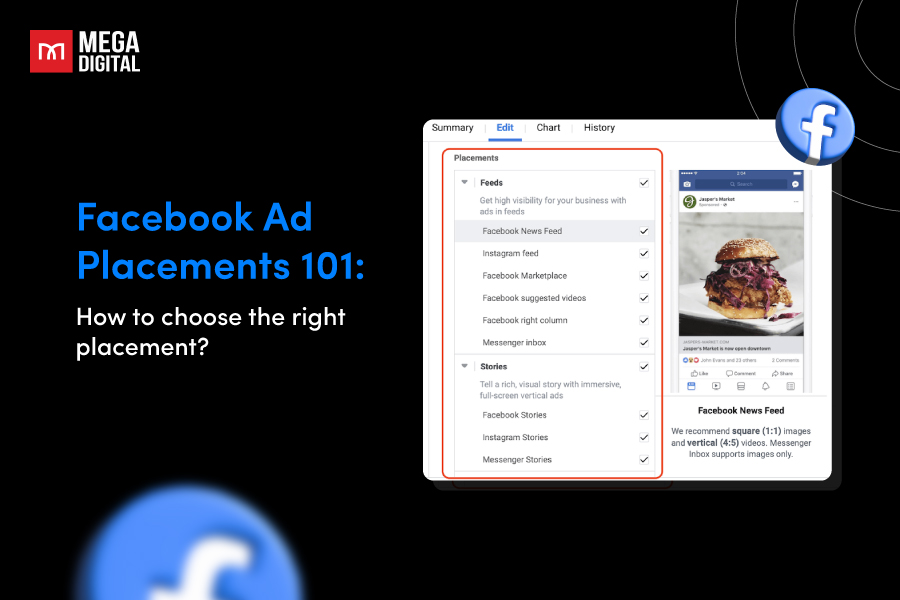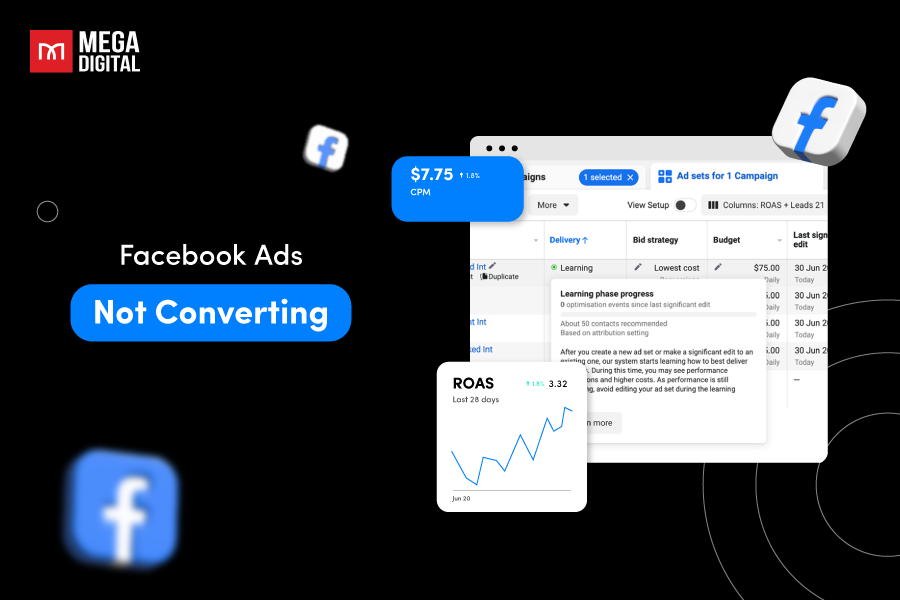Are you new to search arbitrage and looking to understand its various aspects, like search feed arbitrage? If so, you’ve come to the right place. In this article, I’ll guide you through what search feed arbitrage is, how it works, and how to get started. You’ll find everything you need right here, so there’s no need to look elsewhere for additional information. This article has it all covered for you.
QUICK SUMMARY
- Search feed arbitrage = buy low-cost traffic, send it to a monetized search feed (System1, Tonic, Domain Active…), earn on every ad click.
- It’s attractive because it requires minimal content creation, scales fast with large traffic, and can enhance user experience with relevant results.
- Success depends on smart traffic sourcing, choosing the right flow (1-click vs 2-click), testing providers, and continuous optimization with tracking tools.
- This guide covers how it works step by step, top benefits, traffic sources, providers, scaling strategies, best practices for 2025, a real-life case study, and risks to avoid.
- What is Search Feed Arbitrage?
- How does Search Feed Arbitrage work?
- Benefits of Search Feed Arbitrage
- Different Flows of Search Feed Arbitrage
- Types of Traffic Sources for Search Feed Arbitrage
- Search Feed Arbitrage Providers
- How do I start a Search Feed Arbitrage campaign?
- Best Practices for Search Feed Arbitrage (2025)
- Case Study: Example of Search Feed Arbitrage Profitability
- What are the Risks of Search Feed Arbitrage?
What is Search Feed Arbitrage?
Search Feed Arbitrage is a strategy where you purchase traffic and drive it to a monetized page displaying search feed results from providers like System1, Tonic, Domain Active,… You earn money from every click on these search feed results, with higher quality traffic leading to bigger payouts.
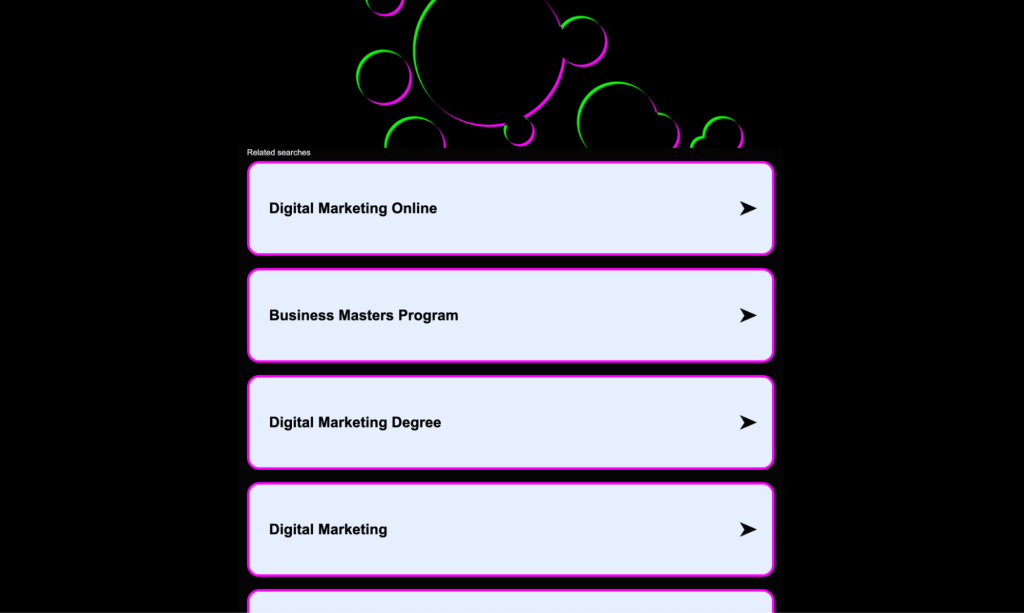
How does Search Feed Arbitrage work?
Search feed arbitrage follows a simple principle: buy traffic for less, monetize it for more. Here’s the step-by-step process:
Step 1: Acquire Traffic
You start by purchasing traffic from different sources such as social media ads, native ads, push notifications, or domain redirects. The goal is to keep the cost per click (CPC) as low as possible.
Step 2: Redirect to a Search Feed Page
Instead of sending users directly to an offer, you redirect them to a search feed page provided by companies like System1, Tonic, or Sedo. This page displays ads or search results relevant to the user’s query or intent.
Step 3: Display Relevant Ads
The search feed provider matches the traffic with ads that are most likely to get clicks, based on user behavior, geography, or keyword relevance.
Step 4: Earn Revenue Per Click (RPC/EPC)
When a user clicks on an ad in the search feed, you earn a payout from the provider. Ideally, this payout is higher than the CPC you paid for the traffic.
Step 5: Optimize & Scale
You track metrics such as EPC, conversion rate, and ROI using tools like Voluum or ClickFlare. Campaigns that show positive ROI can then be scaled with higher budgets.
In short: Buy low-cost traffic → Send to monetized search feed → Earn margin on each click → Optimize for profitability.
Benefits of Search Feed Arbitrage
Have you heard about the benefits of search feed arbitrage? Here are 3 key advantages that can greatly enhance your digital marketing strategy for search arbitrage:
Scalability
Once the system is set up and optimized, it can handle large volumes of traffic. This scalability allows marketers to increase their reach and potential revenue as long as they can maintain a steady supply of traffic and optimize their monetization strategies.
Minimal Content Creation
Search feed arbitrage primarily relies on traffic redirection rather than creating extensive content. This means that marketers can focus more on optimizing traffic sources and monetization methods without the need for constant content production.
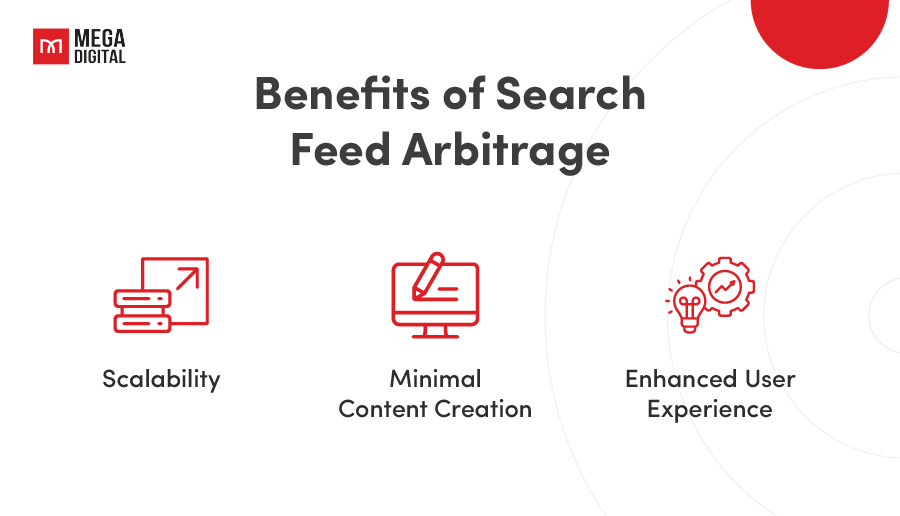
Enhanced User Experience
Properly designed landing pages and search results can enhance the user experience by providing relevant and useful information, which can lead to higher engagement and conversion rates.
Different Flows of Search Feed Arbitrage
Have you ever wondered about the different flows in search feed arbitrage? If you’re not quite sure, don’t worry—let’s break it down together:
1-Click Flow
This method serves visitors directly with promoted links from search feeds like Yahoo or Bing. When a user clicks on an ad, they are immediately taken to the target page, simplifying the process and reducing user drop-off.
Example: A user searching for credit card options with bad credit on Bing types in the query “Bad Credit Credit Cards.” The search results page displays several ads at the top. The user clicks on the first ad for “American Express Cards – Veilig winkelen, ook online”.
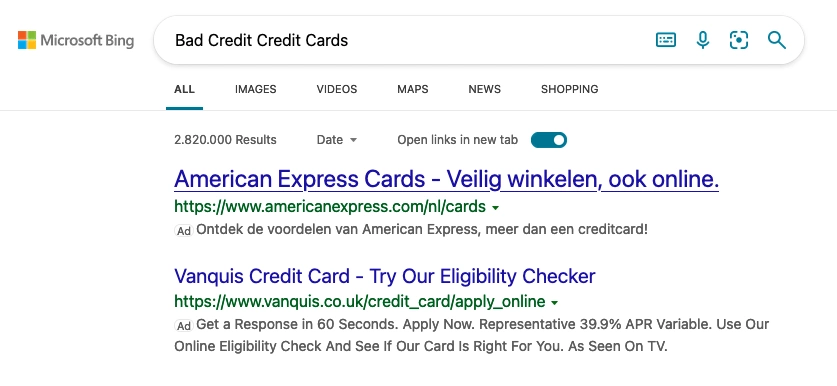
Upon clicking the ad, the user is immediately redirected to the American Express website, where they can find detailed information about various credit card options suitable for individuals with bad credit. The immediate redirection reduces the steps needed for the user to reach their desired information, thereby enhancing the user experience and decreasing the likelihood of drop-off.
2-Click Flow
The approach involves an additional step, where the user is first redirected to an intermediary page before being directed to the monetized search results page. This flow can enhance user engagement and potentially increase the likelihood of clicks on the final monetized page.
Example: The provided screenshot showcases an example of the 2-Click Flow in action. The user first clicks on an ad link like “Seniors: Companies That Buy Life Insurance Policies” or “Sell My Life Insurance for Cash,” leading to an intermediary page with more content and options.
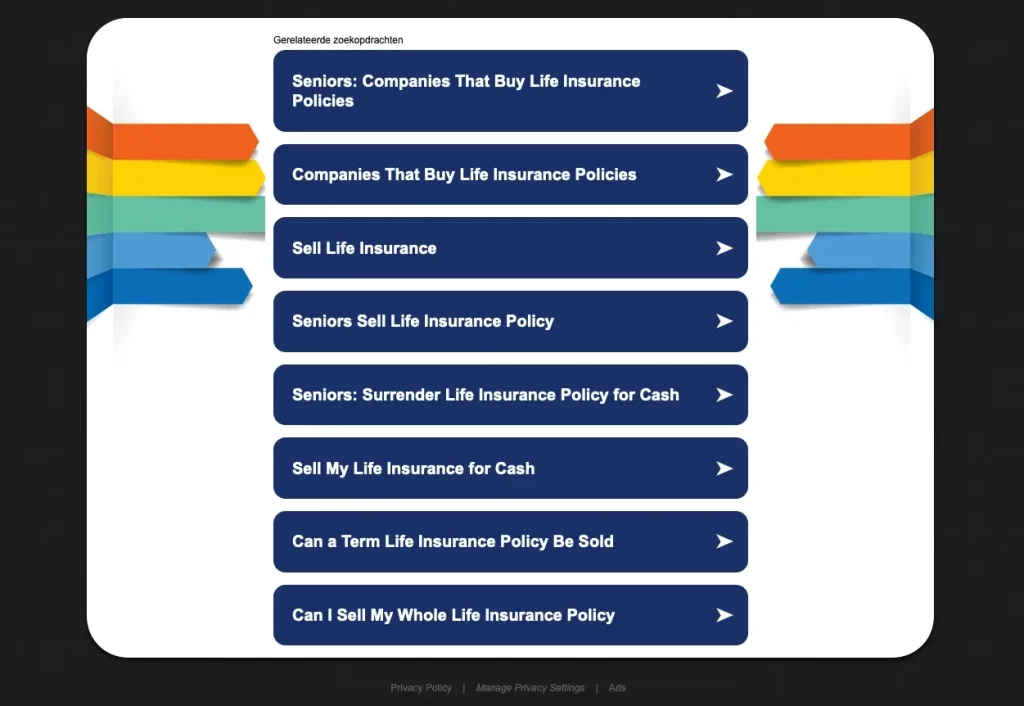
From there, the user clicks again to reach the final monetized search results page, such as “top10quest.com” or “visymo.com.”
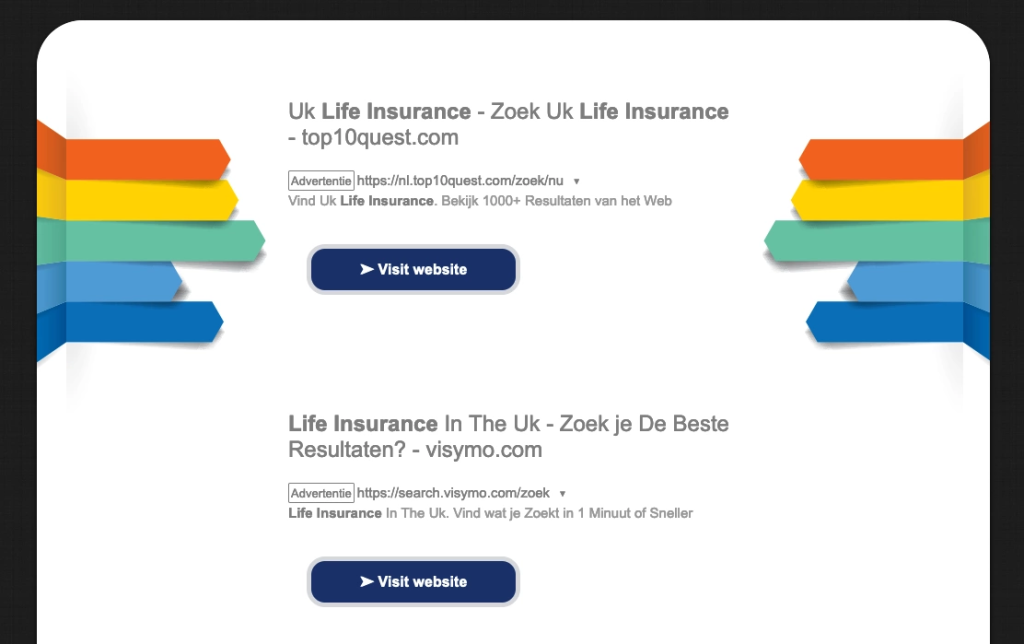
Types of Traffic Sources for Search Feed Arbitrage
Do you know the best places to get traffic for your search feed arbitrage campaigns? Let’s take a closer look at how each one can boost your success.
Paid Advertising
Traffic is generated through paid campaigns on platforms such as Google Ads, Facebook Ads, or other advertising networks. This allows for targeted traffic acquisition based on user demographics, interests, and behaviors.
For instance, targeting users searching for “affordable health insurance” via a Google Ads campaign can attract specific and relevant traffic.
Social Media Traffic
Traffic is obtained from social media platforms like Facebook, Instagram, Twitter, and LinkedIn. This type of traffic can be driven by both organic posts and paid social media ads.
Sharing a blog post about “top legal firms” on LinkedIn can drive visitors from social media to your site, leveraging both organic and paid social media strategies.
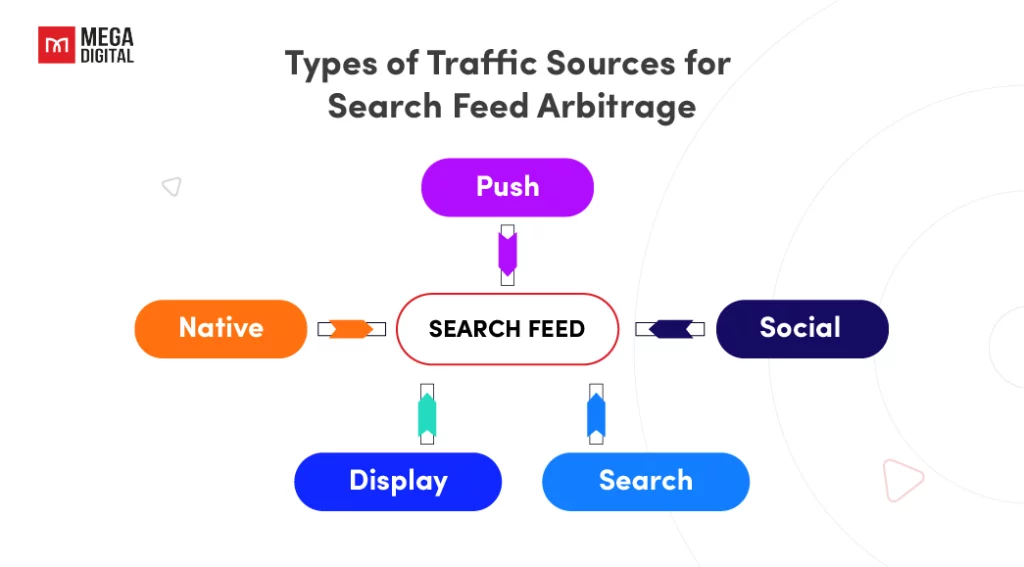
>>> Read more: Social to Search Arbitrage: What is it & How Can You Earn?
Referral Traffic
Visitors come to your website through external links from other websites. This traffic is usually driven by backlinks, guest posts, or collaborations with other sites. Referral traffic can be highly valuable as it often comes from trusted sources and relevant audiences. Besides traditional methods, referral traffic can also be generated through parking domains.
Parking domains can be categorized into Direct-to-Search (D2S) and Navigation-to-Search (N2S) flows:
- D2S (Direct-to-Search): Parking domains directly redirect visitors to a search engine results page with ads, generating referral traffic and revenue. For example, “bestonlinebanking.net” might redirect users to a monetized search results page.
- N2S (Navigation-to-Search): Parking domains redirect visitors first to an intermediary landing page before leading to the search results page. This provides additional context or options. For instance, “onlinebankingguide.com” could take users to an informative page before the search results page.
Search Feed Arbitrage Providers
Search Feed Providers are companies that enable websites to display search results or ads generated by their platforms. They deliver relevant content to users based on their queries or browsing behavior, helping website owners monetize their traffic.
Notable providers include Tonic, System1, Domain Active, and Sedo. These platforms help websites optimize earnings through diverse and high-quality traffic sources, targeted solutions, and comprehensive services. By using these providers, website owners can effectively convert traffic into revenue through strategic search feed arbitrage.
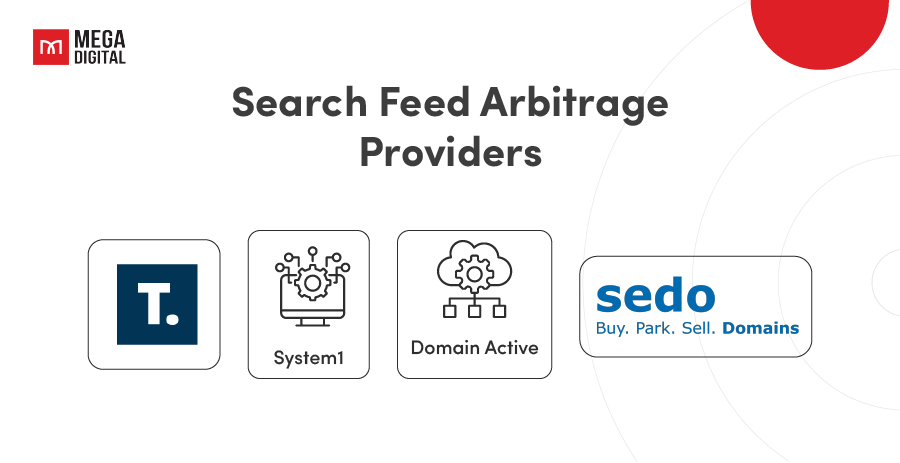
Additionally, using multiple ad networks can help diversify traffic sources, reduce risk, and potentially increase revenue. Popular options include Google Ads, Bing Ads, and native ad networks like Taboola and Outbrain.
>>> Read more: Top 5 Search Feed Providers: How to Choose the Right One?
How do I start a Search Feed Arbitrage campaign?
Now that you have a good understanding of search feed arbitrage, it’s time to learn how to start your own campaign. Here’s a step-by-step guide to get you going:
Step 1: Choose suitable traffic sources and monetization platforms
To begin, identify the best sources for acquiring traffic. Consider platforms like Google Ads, Facebook Ads, and native advertising networks such as Taboola and Outbrain. These platforms allow for targeted traffic acquisition based on user demographics, interests, and behaviors.
Pair these with reliable monetization platforms like Google AdSense, Yahoo Search, Bing Ads, or specialized search feed providers like Tonic, System1, Domain Active, and Sedo. The right combination of traffic sources and monetization platforms will set the foundation for your campaign’s success.
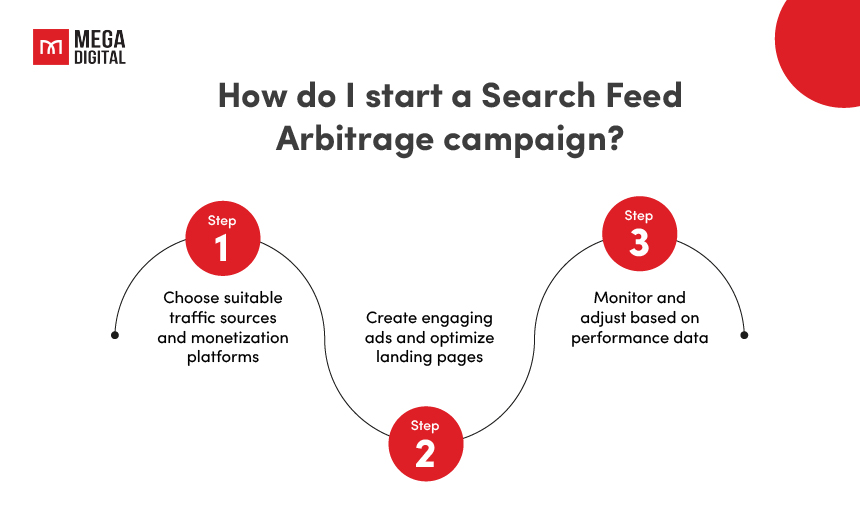
Step 2: Create engaging ads and optimize landing pages
Develop ads that are not only visually appealing but also highly relevant to your target audience. Use compelling headlines, clear calls to action, and engaging visuals to attract clicks. Ensure your landing pages are optimized for conversions by focusing on user experience (UX) and user interface (UI) design.
This includes fast loading times, mobile responsiveness, and intuitive navigation. The content on your landing pages should be valuable and relevant, addressing the needs and interests of your visitors. A/B testing different ad creatives and landing page elements can help identify what resonates best with your audience.
Step 3: Monitor and adjust based on performance data
Continuously track your campaign’s performance using analytics tools such as Google Analytics, Facebook Analytics, or specific tools provided by your ad and monetization platforms. Key metrics to monitor include click-through rates (CTR), conversion rates, cost per click (CPC), return on ad spend (ROAS), and overall revenue.
Analyze this data to identify trends, strengths, and areas for improvement. Based on these insights, make informed adjustments to your ad creatives, targeting criteria, and landing page elements. Regular optimization is crucial for maintaining and improving campaign performance over time.
Best Practices for Search Feed Arbitrage (2025)
Success in search feed arbitrage depends on more than just arbitraging CPC differences. With stricter ad policies and smarter algorithms in 2025, here are the best practices to follow:
Prioritize Traffic Quality: Low-quality or bot traffic can get you banned by feed providers. Focus on GEOs, devices, and demographics that match high-intent users.
Stay Compliant with Policies: Google, Bing, and feed providers enforce strict compliance rules. Avoid misleading creatives, cloaking, or incentivized clicks to keep your accounts safe.
Test Multiple Providers: EPC rates vary. A provider like System1 may perform better in finance niches, while Tonic might work well for general traffic. Always A/B test.
Leverage 2-Click Flows: While 1-click flows are simple, 2-click flows with pre-landing pages often bring higher EPC and better data tracking. Pre-landers also allow extra monetization (e.g., banner ads).
Invest in Tracking & Analytics: Tools such as Voluum, RedTrack, or ClickFlare give you real-time insights into ROI, helping cut losses fast and double down on winners.
Choose Profitable Niches: Finance, insurance, antivirus, education, and travel are among the highest-paying verticals in arbitrage. Selecting the right niche maximizes returns.
Case Study: Example of Search Feed Arbitrage Profitability
Let’s walk through a simple example to illustrate how profitability works:
- Traffic Source: Facebook Ads
- Campaign Target: Travel deals
- Ad Spend (CPC): $0.80 per click
- Total Clicks Purchased: 1,000 clicks → Cost = $800
- Redirection: Users land on a travel-focused search feed (provided by System1).
- Search Feed Earnings (RPC/EPC): $1.50 per click
- Clicks on Feed Ads: 600 clicks (60% click-through rate on feed)
- Revenue Earned: 600 × $1.50 = $900
- Profit: $900 – $800 = $100
Though the margin is only 12.5%, it can be scaled. If you increase daily spend from $800 to $8,000 while maintaining ROI, profits jump from $100 to $1,000 per day.
What are the Risks of Search Feed Arbitrage?
While search feed arbitrage offers several benefits, it also comes with certain risks that you should be aware of. Here are some key risks to consider:
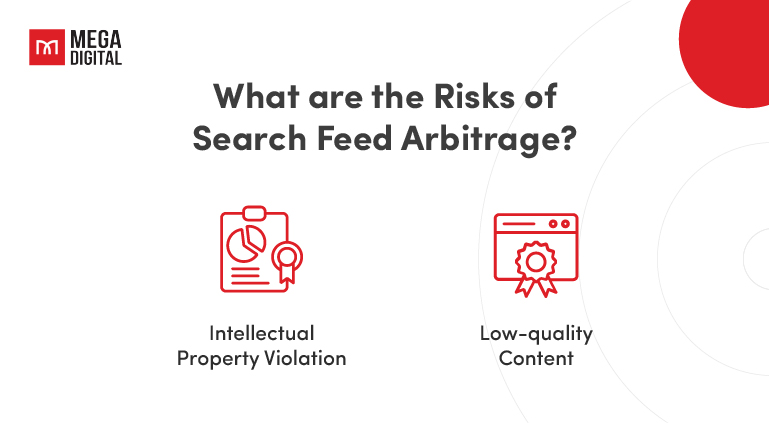
Intellectual Property Violation
One of the primary risks of search feed arbitrage is the potential for violating intellectual property rights. For example, if you extract and use copyrighted images or text from search feeds without permission, you might face legal issues and fines. Reputable search engines like Google may penalize or ban websites engaging in this practice, harming their visibility and credibility.
Low-quality Content
Another risk of search feed arbitrage is the lack of originality and value in the content produced. For instance, if your website simply repackages existing articles without adding unique insights, users may find it unengaging. This can result in a poor user experience, and search engines may penalize your site for low-quality content, negatively impacting your search rankings and audience retention.
Wrap up
We hope this article has helped clarify search feed arbitrage for you. Search feed arbitrage can bring many benefits, like increased revenue and broader reach, but it also comes with risks. It’s important to be careful and strategic to make the most of this marketing approach.







